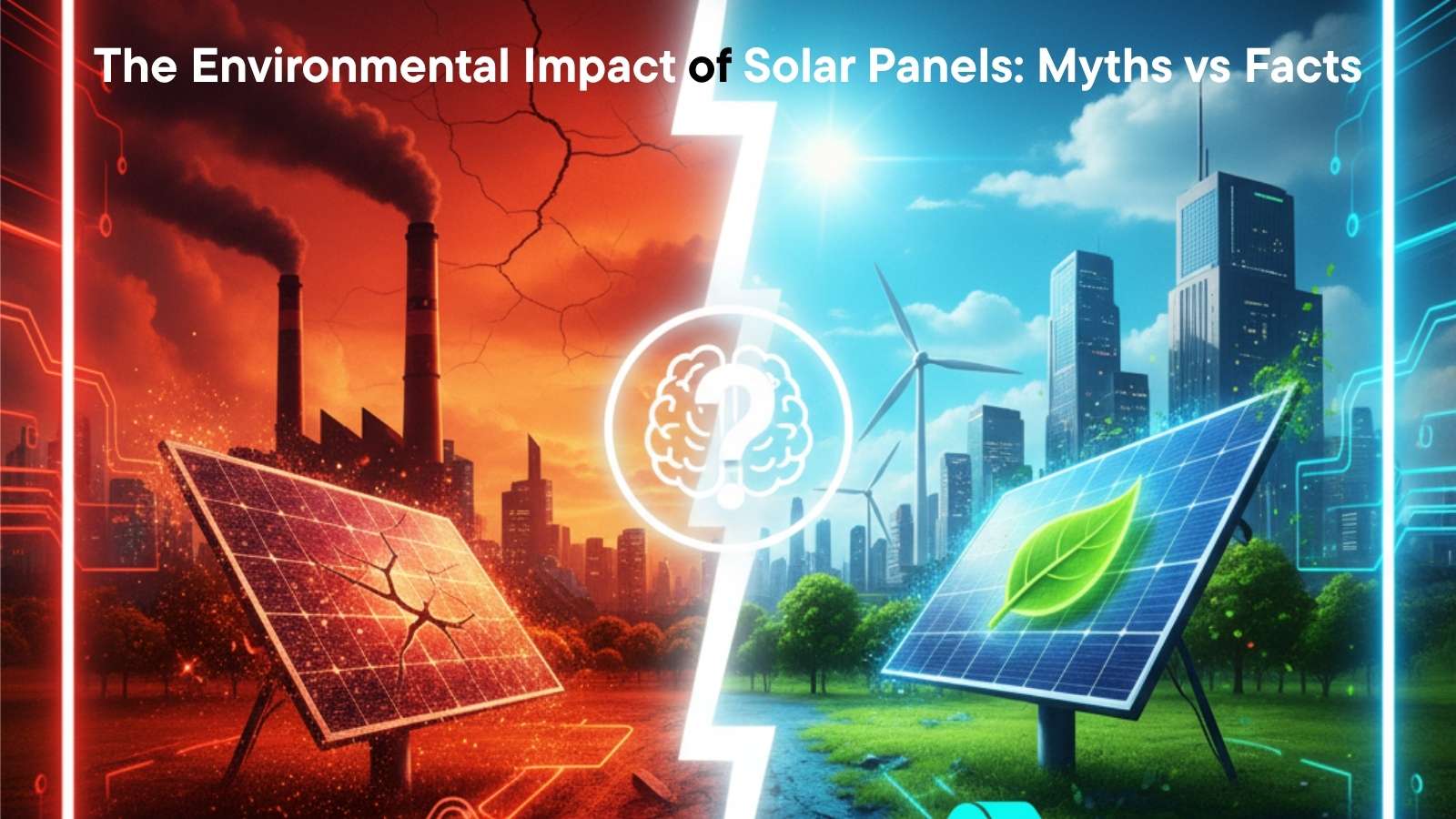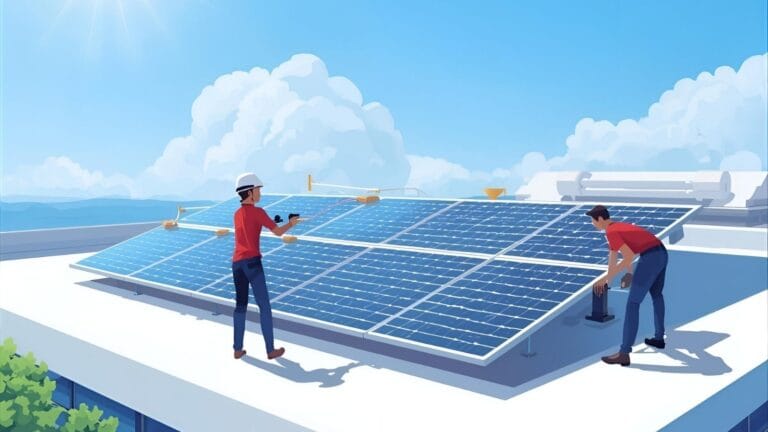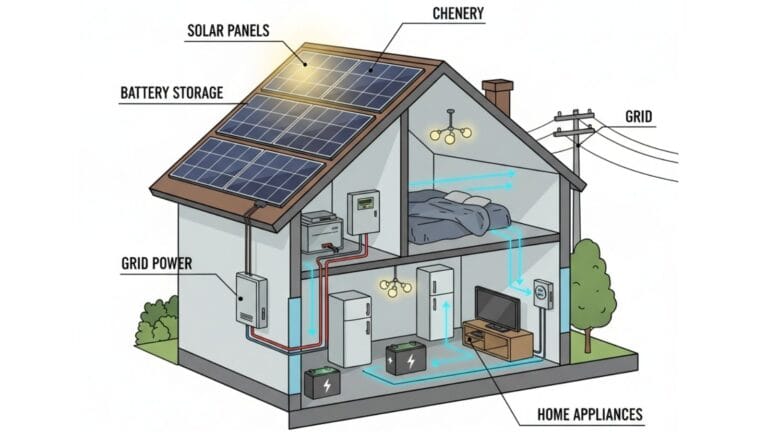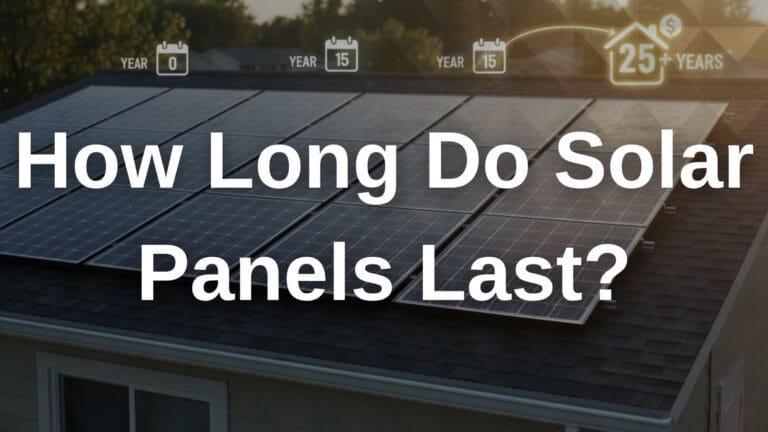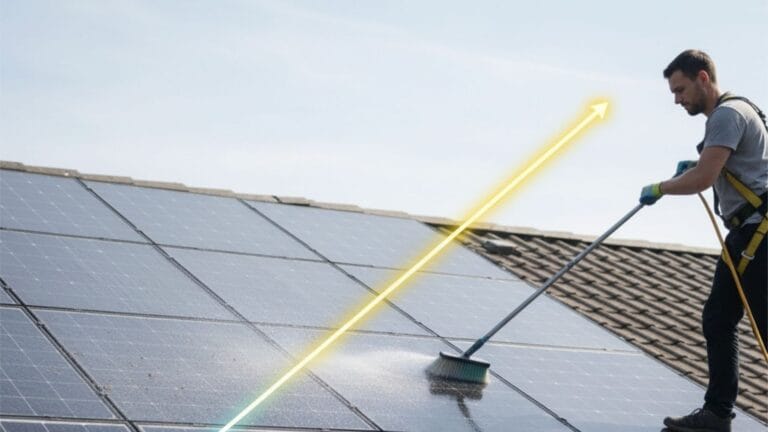The Environmental Impact of Solar Panels: Myths vs Facts
Solar power has become one of the fastest-growing renewable energy technologies worldwide, and it’s easy to see why. Governments, corporations, and communities are increasingly relying on photovoltaic (PV) systems to meet ambitious climate targets and reduce their dependence on volatile fossil fuels. However, as solar has moved from a niche technology to a mainstream power source, public discussions have been filled with misconceptions about its true environmental impact.
As an energy professional, I believe it’s critical to separate fact from fiction. This guide provides an in-depth, evidence-based analysis of those common claims, addressing the myths head-on and presenting documented facts from reliable sources and industry research. This is not a surface-level overview; every section is written with a focus on clarity and technical accuracy to support decision-makers and professionals in the energy field. We’ll explore the entire lifecycle of a solar panel, from manufacturing to recycling, to give you a complete and unbiased picture.
Lifecycle Perspective: From Raw Materials to End of Life
When evaluating the environmental impact of solar panels, it’s crucial to look at more than just the clean energy they produce. Specialists in the field emphasize examining the entire lifecycle of a panel, from its very beginning to its end. Only by looking at the complete chain—from the extraction of raw materials to decades of operation and eventual decommissioning—can a fair and accurate assessment be made.
Raw Materials and Manufacturing
The journey of a solar panel starts with raw material extraction. Silicon, the primary material, is derived from quartz, which requires mining and purification. The aluminum frames need bauxite mining and smelting. A small amount of silver is also used in cell conductors. While these steps do generate emissions and waste, industry reports show that ongoing efficiency gains and better supply chain oversight are making these processes cleaner. Similarly, the conversion of raw silicon into high-purity wafers is an energy-intensive process. However, according to assessments from the International Energy Agency (IEA), new factories are increasingly powered by renewable energy, which is rapidly reducing the carbon intensity of manufacturing.
Transport, Operation, and End of Life
The transport and installation of modules add emissions, but these are typically a very small fraction—less than 5%—of the total lifecycle impact. The real environmental benefit comes during the operation phase. Once installed, panels generate electricity for 25 to 30 years without any direct emissions. Over this long lifespan, they offset many times the emissions created during their production. The final piece of the puzzle is end-of-life management. Here, the industry is making major strides. European Union directives, such as the WEEE (Waste Electrical and Electronic Equipment) directive, now require manufacturers to implement take-back and recycling schemes. This ensures that valuable materials are recovered and reused rather than being sent to a landfill, closing the loop on a truly sustainable technology.
Myth: Manufacturing Solar Panels Produces More Emissions Than They Save
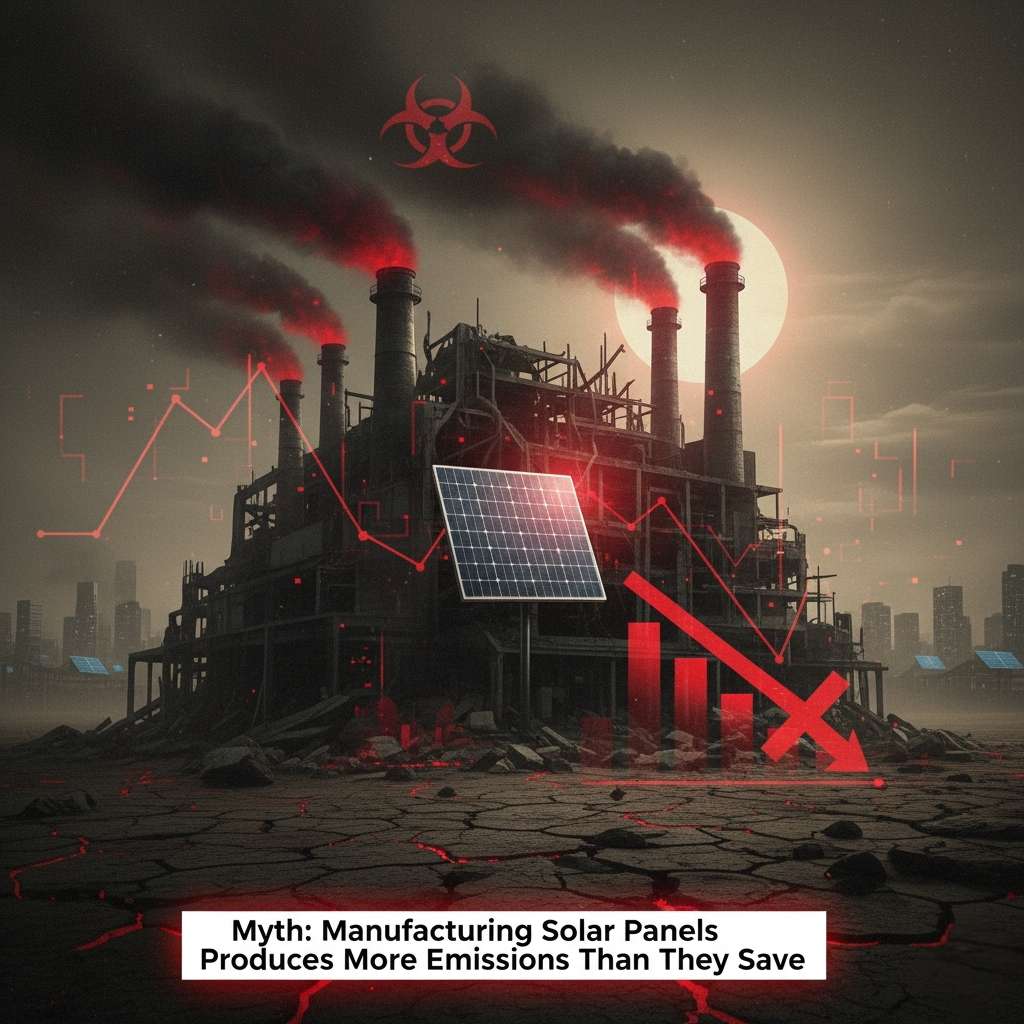
A common misconception, often pushed by critics, is that solar panels require more energy to produce than they can ever generate. This claim focuses solely on the energy used during manufacturing, completely ignoring the decades of clean power a panel provides. However, research from the National Renewable Energy Laboratory (NREL) and multiple peer-reviewed studies shows a very different story.
The concept of Energy Payback Time (EPBT) is used to directly counter this myth. EPBT calculates exactly how long it takes for a solar panel to generate the same amount of energy that was consumed during its entire lifecycle—from raw material extraction to manufacturing and transport.
Depending on the technology and the amount of sun a location receives, the EPBT for a modern solar panel is typically very short, ranging from just 1 to 3 years. After this period, every single kilowatt-hour produced is a net reduction in emissions compared to electricity generated from fossil fuel sources. Over its long lifespan of 25 to 30 years, a single residential solar system can prevent several tons of CO₂ from entering the atmosphere. This myth often persists because many older, outdated statistics are cited without context, but current data consistently and conclusively demonstrate the overwhelming net benefit of photovoltaic systems.
Myth: Solar Panels Cannot Be Recycled
Another persistent myth suggests that PV modules cannot be recycled and will inevitably end up in landfills. The reality is quite the opposite, as multiple recycling methods are already in practice, and the industry is rapidly scaling up these capabilities.
For example, the European Commission has established clear protocols under the Waste Electrical and Electronic Equipment (WEEE) directive, which legally requires producers to handle end-of-life panels responsibly. The processes involve a combination of mechanical, chemical, and thermal treatments to recover valuable materials. This includes mechanical separation of the glass and aluminum frames, chemical treatment to recover the high-purity silicon, and even thermal processing for other components.
The recovery rates are already quite impressive, which makes the process not just an environmental imperative but also economically viable. Currently, up to 95% of the glass and over 80% of the silicon can be reused. Countries like Germany, France, and Japan have operational, dedicated facilities for PV recycling, and the United States is expanding similar capabilities through both private and public initiatives. While the challenge remains in scaling these systems globally to meet the volume of future waste, the technology and policy frameworks are already in place, making the “landfill myth” a thing of the past.
Fact: Manufacturing Requires Energy and Raw Materials
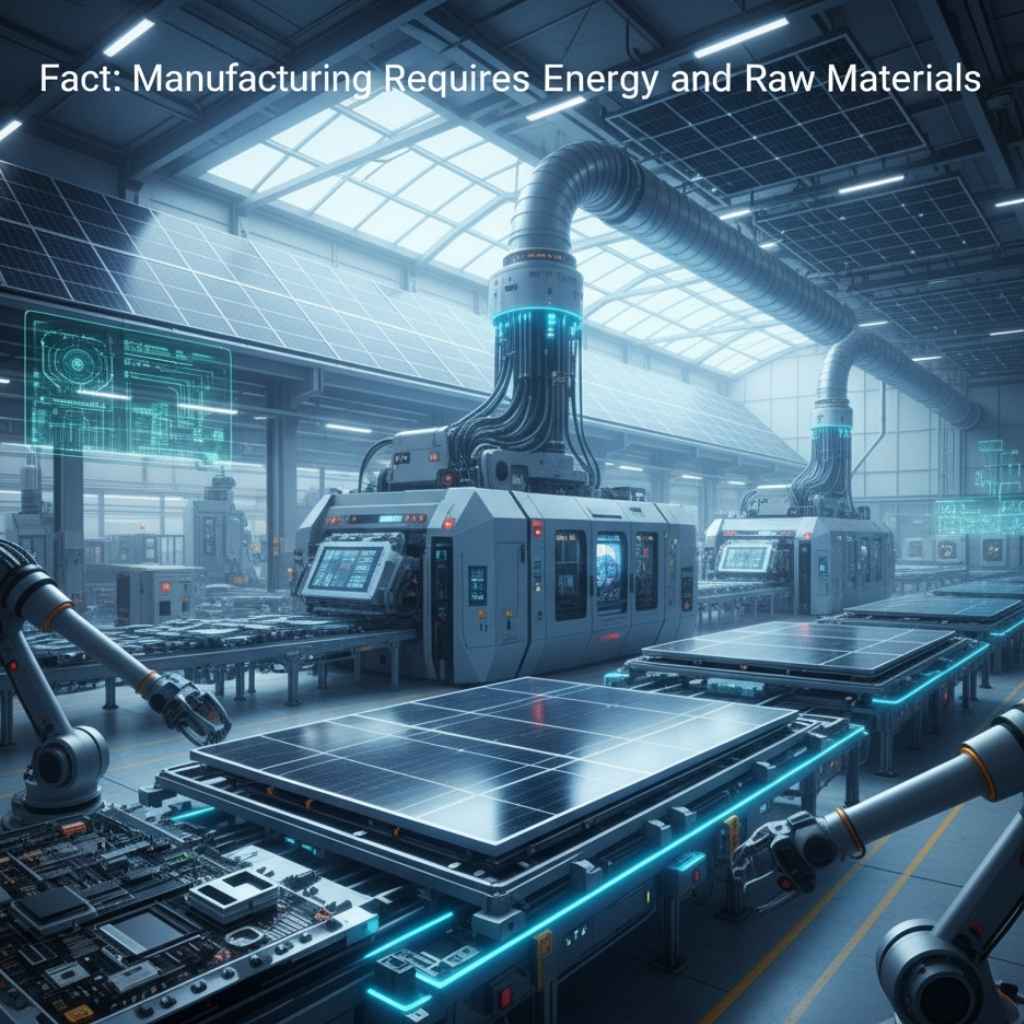
It is important to acknowledge that the environmental cost of producing solar panels is not zero. While they provide clean energy for decades, their manufacturing process does have an impact. For example, silicon purification requires high-temperature furnaces, and frame materials like aluminum have significant embodied energy—the energy consumed during their production. However, it’s also true that the industry is making huge strides to mitigate this.
According to industry data from BloombergNEF, the average embodied carbon per watt of PV output has fallen steadily over the past decade. This is thanks to manufacturers improving their processes, making them more efficient, and increasingly relying on renewable energy to power their factories. This continuous improvement in production methods remains a top priority for both manufacturers and regulators.
Beyond the main components, you have to consider auxiliary parts like backsheets, encapsulants, and junction boxes, all of which require their own raw materials and have their own supply chain impacts. As a result, experts consistently recommend a greater use of recycled materials and the adoption of closed-loop supply chains to further reduce these footprints. Many leading companies now publish comprehensive sustainability reports outlining their progress toward these important goals, demonstrating a clear commitment to making solar a truly green technology.
Myth: End‑of‑Life Solar Panels Will Overwhelm Landfills
High-level forecasts from organizations like the International Renewable Energy Agency (IRENA) estimate that by 2050, global photovoltaic (PV) waste could reach tens of millions of metric tons. While that number is significant and can sound alarming, context is crucial.
First, these panels will have provided decades of clean, zero-emission electricity before they reach end-of-life. Their environmental debt has long been paid off by the time they are decommissioned. Second, and most importantly, studies consistently highlight that over 90% of the material mass in typical panels is either recyclable or reusable. These aren’t worthless items destined for a landfill; they are a valuable source of glass, aluminum, silicon, and other precious metals.
With proper policy, infrastructure, and market incentives, these materials can be returned to the production cycle. Extended Producer Responsibility (EPR) programs are a key solution, and they’re already being adopted in several markets. These programs require manufacturers to fund recycling and collection, ensuring the end-of-life process is built into the system from the beginning. Ultimately, rather than overwhelming landfills, end-of-life panels are poised to become a valuable source of secondary raw materials, further reducing the need for virgin resource extraction and completing the circular economy model for solar.
Fact: Solar Panels Significantly Reduce Greenhouse Gas Emissions
Life-cycle analysis consistently shows that solar power is, without a doubt, one of the lowest-carbon energy sources available today. The numbers speak for themselves. Data from the National Renewable Energy Laboratory (NREL) indicate that the average lifecycle emissions for solar are just 20–50 grams of CO₂ equivalent per kilowatt-hour (g CO₂e/kWh).
To put that into perspective, a natural gas plant emits roughly 450–500 g CO₂e/kWh, and a coal plant exceeds 900 g CO₂e/kWh. The difference is not just significant; it’s massive. These gains accumulate quickly across large installations, making solar a powerful tool for reducing a nation’s carbon footprint. National studies confirm that widespread adoption of solar can play a crucial role in meeting the ambitious climate targets set by the Paris Agreement and other international frameworks.
Beyond just carbon savings, PV systems also reduce local pollutants like nitrogen oxides and sulfur dioxide, which supports public health objectives in urban areas where air quality is a major concern. These benefits are immediate and measurable once a system becomes operational, making solar a truly holistic solution for a cleaner, healthier future.
Additional Environmental Benefits

Additional Environmental Benefits
While the reduction in carbon emissions is the most frequently cited benefit of solar energy, the advantages of widespread solar adoption extend much further. These additional benefits are often overlooked in public discussions that focus solely on emissions, yet they add meaningful environmental value to PV deployments.
Water Conservation
One of the most significant, and often unacknowledged, benefits is water conservation. Unlike thermal power plants—such as coal, natural gas, or nuclear facilities—that require enormous volumes of water for cooling, solar panels operate without any significant water use. This makes solar a perfect fit for arid regions where water resources are scarce, helping to preserve this critical resource for communities and ecosystems.
Air Quality Improvement
Solar power has a direct, positive impact on public health. The operation of a solar system produces no sulfur dioxide, nitrogen oxides, or particulate matter. These pollutants are major contributors to smog and respiratory diseases, particularly in urban areas. By replacing fossil fuel generation with solar, we can significantly improve air quality and, as a result, reduce public health costs and improve the quality of life for millions of people.
Land-Use Optimization
Solar energy systems are highly adaptable and don’t require the vast, dedicated tracts of land that other power sources do. Panels can be installed on rooftops, which are otherwise unused spaces. They can also be integrated into parking structures, providing shade while generating power. Even in rural areas, innovative concepts like agrivoltaics allow solar panels to be installed over crops, providing both shade for agricultural output and clean energy, thus minimizing new land disturbances and maximizing the utility of a single piece of land.
Research and Innovation
Ongoing research continues to reduce the footprint of solar manufacturing and improve recycling methods. This is an industry that is constantly self-improving, driven by both technological innovation and a strong commitment to sustainability.
Advancements are happening on multiple fronts. For example, research into lead-free perovskite cells is creating a new generation of more sustainable panels. Additionally, improved silicon wafer slicing techniques are reducing material waste, and the increasing trend of manufacturing powered by renewable energy is directly lowering the carbon emissions associated with production. Reports from industry authorities like BloombergNEF and the International Energy Agency (IEA) consistently note steady reductions in embodied energy per watt of PV output year over year, showing clear, measurable progress.
On the recycling front, innovations are making it possible to recover a greater percentage of valuable materials. This includes advanced thermal processes, laser-based separation for thin-film modules, and new chemical recovery methods to reclaim high-purity materials like silicon and silver. The integration of these cutting-edge methods into large-scale operations is a critical step that will further lower the long-term environmental impact of PV technology, ensuring the solar industry becomes a truly circular economy.
Policy and Industry Recommendations
The solar industry has made incredible strides in efficiency and sustainability, but to ensure it remains a truly green cornerstone of our future energy systems, there’s more work to be done. This is where smart policy and proactive industry leadership become critical. By implementing these measures, governments and industry stakeholders can secure solar’s long-term environmental viability.
- Expand Extended Producer Responsibility (EPR) For a circular economy to work, the responsibility for a product’s lifecycle can’t just fall on the consumer. We need to expand global Extended Producer Responsibility (EPR) programs to ensure that manufacturers are financially and operationally responsible for funding the collection and recycling of their panels. This creates a powerful incentive for companies to design products that are easier to recycle and less harmful to the environment from the start.
- Invest in Recycling Infrastructure To handle the tens of millions of metric tons of panels expected to reach end-of-life in the coming decades, we need a robust recycling network. Governments and private investors must encourage and invest in new recycling infrastructure to handle these projected volumes efficiently. This isn’t just about waste management; it’s about creating new, valuable supply chains for secondary raw materials that will reduce reliance on mining.
- Promote Green Manufacturing The manufacturing process itself is a key area for improvement. Policies should promote the adoption of renewable energy in manufacturing to further reduce the embodied carbon of solar panels. By powering factories with solar and wind, we can cut a panel’s carbon footprint before it even leaves the production line, making it a true net-zero technology.
- Demand Transparency For consumers, investors, and policymakers to make informed decisions, transparency is essential. Regulators should require transparent life-cycle assessments and public reporting from all major PV producers. This would provide clear, comparable data on environmental impacts, holding companies accountable and driving continuous improvement across the industry.
By implementing these measures, we can ensure that solar power doesn’t just reduce our reliance on fossil fuels but also stands as a model of a truly sustainable and responsible energy technology for generations to come..
The Overwhelmingly Positive Impact of Solar
In the final analysis, the environmental impact of solar panels is complex but overwhelmingly positive. When you look at the full picture—from raw material sourcing to long-term operation and eventual recycling—the data consistently shows that solar is a critical tool for building a sustainable future. While production and end-of-life management do present challenges, these are being actively addressed through relentless technological improvements and forward-thinking policy frameworks.
The myths suggesting that solar panels cause more harm than good are simply not supported by the data. In reality, solar energy remains one of the most effective tools available to combat climate change, with a lifecycle carbon footprint that is many times smaller than fossil fuels. Beyond just emissions, it also helps conserve water, improve air quality in our cities, and optimize land use through innovative designs like agrivoltaics.
Ultimately, solar power is more than just a clean technology; it’s a proven, scalable solution that offers a clear path away from fossil fuels. By continuing to support innovation, robust recycling initiatives, and smart policy, we can ensure that solar remains a truly sustainable cornerstone of our global energy system for generations to come. The path forward is bright, efficient, and powered by the sun.
You can also maximize the efficiency you get from solar panels by reviewing our article titled “How to Clean and Maintain Solar Panels for Maximum Efficiency?”

Solar Energy Enthusiast & Renewable Energy Researcher
Vural’s journey into solar energy began four years ago, driven by frequent power outages and high electricity bills at his own home. He has since gained hands-on experience with both personal and commercial solar projects. At solarpanelresource.com, Vural shares his real-world insights and in-depth research to guide homeowners and business owners on their own path to energy independence.

